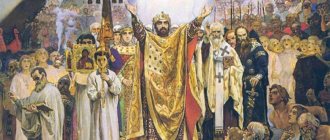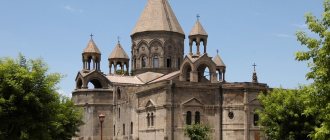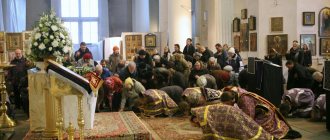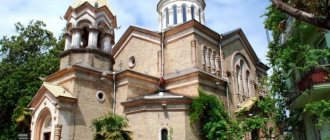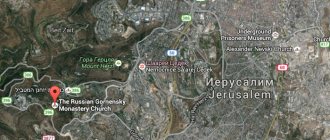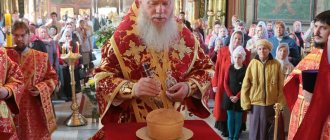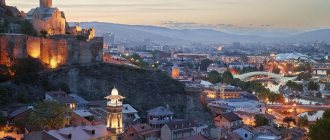Georgia is the Transcaucasian country closest to Russia, with which it is connected not only by faith, and the baptism of Georgia occurred 664 years before the baptism of Rus', but by history and culture. Many glorious names of Orthodox saints, kings, great generals, poets, writers, musicians and actors connect the two great countries. But the most important thing is the spiritual kinship of the peoples living in our countries.
Lot of the Blessed Virgin Mary
Christianity in Georgia originated during the time of the first apostles. Iberia went to the Mother of God by lot, when the first apostles chose countries to preach Christ. But by the will of God this mission was entrusted to the Apostle Andrew.
According to legend, the apostles Matthew, Thaddeus, and Simon Cannait, who suffered martyrdom there, also carried out preaching activities there. The emergence of Christianity was not easy. At the very beginning of its development, it was subjected to persecution for almost three hundred years. King Farsman 1st in the first century carried out brutal persecution of Christians citing hard labor in Tauris.
The history of the formation of Orthodoxy in Georgia deserves special attention, because all the events associated with the baptism of Georgians have specific historical dates, and individual facts of miracles associated with this phenomenon are taken not from legends and traditions, but from actual events witnessed by eyewitnesses .
Orthodoxy received official recognition in Georgia in 324. This great event is associated with the names:
- Saint Nino of Cappadocia. Her preaching contributed to the adoption of baptism by Georgians.
- King Mirian, who turned to faith thanks to Saint Nina and miraculous healing from the blindness that struck him when he turned to the Lord.
- Holy Queen Nana.
It is impossible to imagine Orthodox Georgia without these names.
Saint Nino was born in Cappadocia into a Christian family and received an appropriate upbringing from childhood. Even in her youth, fleeing the persecution of Emperor Diocletian in 303, she, among 37 Christian girls, fled to Armenia, where she miraculously escaped death, and then to Iberia, where she preached Christ.
Georgian Orthodox Church
The relatively small Caucasus region has been home to many peoples from time immemorial. It is now difficult to determine the boundaries between their settlement zones and to clearly divide countries along religious lines. For example, many people are interested in what kind of faith Georgians have.
Most Georgians profess Orthodoxy. With a population of 3,723,000 people, about 85% consider themselves Orthodox (2014 census data). Islam is professed by 10% of the population, parishioners of the Armenian Apostolic Church make up approximately 3%.
Divine service in the temple of the Georgian Orthodox Church
Baptism
The ruling Georgian king Marian and his wife Nano were staunch pagans. Thanks to Nino’s prayers, the queen, who had been seriously ill for a long time, was healed and received baptism from the saint, which aroused the wrath of the king, who was ready to execute both women. But on July 20, 323, a story similar to what happened to the Apostle Paul happened to him.
While on a hunt and learning that his wife, Queen Nano, had been baptized, he angrily vowed to execute her and Nino. But as soon as he began to threaten Nino and the queen with execution and blaspheme, he immediately became blind. He received no help from his idols and in despair turned to Christ in prayer. His vision returned.
These events took place in the spring of 323, and on May 6 of the same year, healed from sudden blindness and believing in the power of Christ, the Georgian king Mirian converted to Orthodoxy. This event became a turning point in the history of Georgia, since after his conversion the king became a staunch promoter of Orthodoxy in his country.
On October 14, 324 (according to some sources in 326) in Mtskheta on the Kura River, Bishop John, specially sent for this purpose by Tsar Constantine the Great, baptized the people. Tens of thousands of Georgians were baptized that day. This date is the time of the beginning of the baptism of Georgia. Since that time, Orthodoxy has become the official state religion.
To commemorate the victory of Christianity, crosses were erected in the Kartli mountains. And in Mtskheta, King Mirian, who laid the foundation for the construction of churches, built the first Orthodox church in the temple history of the country, Svetitskhoveli (life-giving pillar), that is, the Cathedral of the Twelve Apostles. If you happen to visit Georgia, be sure to visit this temple.
After baptism, Orthodox Georgia never returned to paganism. Crowned apostates who tried to persecute believers in Christ appeared periodically. But the Georgian people never abandoned their faith.
Moreover, there are many known facts of the massive feat of Georgians in the name of the faith of Christ. A well-known historical fact is that in 1227, Muslims led by Shahinshah Jalal Ed Din took Tbilisi and the townspeople were promised the preservation of their lives in exchange for the desecration of the icons placed on the bridge over the Kura River. 100,000 townspeople, including women, old people and children, simple monks and metropolitans chose death in the name of Christ. There are many such examples in the history of Georgia.
Throughout the history of Orthodoxy in Iveria, it had to withstand repeated attempts not only to forcefully destroy it, but also to pervert the purity of its teaching:
- Archbishop Mobidag (434), tried to introduce the heresy of Arianism. However, he was exposed, deprived of power and excommunicated from the Church.
- There were attempts to introduce the heresies of Peter Fullon.
- Albanians (in 650) with their heresy of Manichaeism.
- Monophysites and others.
However, all these attempts were failed, thanks to the Council of Shepherds who harshly condemned heresies, the people who did not accept such attempts, Catholicos Kirion, who forbade believers from any communication with heretics, and the metropolitans who stood firm in the faith and enlightened the believers.
Georgians, who have managed to defend the purity and piety of their faith for many centuries, have earned the respect of even foreign believers. So the Greek monk Procopius wrote: “The Iverians are the best of Christians, the strictest guardians of the laws and regulations of Orthodoxy.”
Today, 85% of Georgians consider themselves Orthodox; the Constitution of the state notes the large role of the Church in its history. This was confirmed once again in his speech by Prime Minister Irakli Kobakhidze, who wrote: “The Church has always fought for the freedom of Georgia.”
Georgia as part of Russian Orthodoxy
In 1801, Georgia became part of the Russian Empire. Since the Russian Church was in a position subordinate to the state, serious changes in the Georgian Church were inevitable. The rank of Patriarch-Catholicos as the supreme hierarch of the Georgian Church was abolished. As in the rest of Russia, church administration began to be carried out by the Holy Synod, acting on behalf of the emperor.
The number of Georgian dioceses also decreased significantly (instead of 13, 2 remained). The local Church acquired the status of an exarchate of the Russian Church. Changes that took place in the religious sphere often led to conflicts between believers, clergy and secular authorities. Many did not support the Russification of national Orthodoxy. The Georgian Church found itself completely subordinated to the religious policies of the Empire. At this time, the rich ancient traditions of hymnography, icon painting, and church art began to disappear from Georgian everyday life. The veneration of many Georgian saints is fading away.
The February Revolution of 1917 and the overthrow of the monarchy served as the impetus for serious changes. In March 1917, the Georgian Church proclaimed autocephaly. Patriarch of Moscow and All Rus' Tikhon condemned this unauthorized separation. Communication between the Churches was interrupted for a while and restored only in 1943.
During Soviet rule, the Orthodox Church of Georgia was subjected to repression along with Christians throughout the Soviet Union. In 1921, there were 1,450 active churches and 25 monasteries, 1,600 clergy in Georgia. Over the next two years, more than 1,200 parishes were closed and destroyed. Most of the priests were shot or repressed.
In 1990, only 296 parishes and 11 monasteries remained in the Georgian Orthodox Church.
A letter of revelation?
A letter that Mamaladze allegedly sent to Ilia II two months before his arrest also added fuel to the fire. In his message, the clergyman says that the Georgian patriarchate is mired in corruption. In particular, we are talking about a debt of 110.5 million rubles, which accumulated as a result of fraud. Also, according to media reports, the letter states that companies owned by the patriarchy are allegedly engaged in commerce, including the production of alcohol and trading in oil. At the same time, Mamaladze asks the patriarch for his blessing to conduct an audit. The authenticity of the letter is still in doubt among many.
How is it different from Russian?
The Georgian parish received final autonomy when members of the Patriarchate of Constantinople recognized autocephaly in 1990.
As for the differences between the Georgian and Russian churches, they lie in nuances and history:
- the Georgian church was formed 700 years earlier than the Russian one;
- there are differences in liturgical language;
- each has characteristic architectural and iconographic features.
But in the most important thing - in faith - the two peoples are absolutely similar.
Temple of Bagrat
The Bagrati Temple has become one of the World Heritage Sites, which is protected by UNESCO. This decision was reached by UNESCO specialists who were against the decision of President Mikheil Saakashvili to begin construction to restore the Temple to its original form in 1003.
However, Saakashvili not only did not stop the construction, but on August 17, 2012, a two-meter bronze cross weighing 300 kg was installed on the dome of the Bagrati Cathedral. At this ceremony, Saakashvili stated that the cathedral was destroyed by Russian artillery, while only the Turks were involved in the destruction of the Temple.
The first King of Georgia, Bagrat III, in whose honor the Temple was built at the end of the 10th century, allocated a special purpose to this place; not only were all significant events of that time held here, but local residents found protection in turbulent times during enemy attacks. Therefore, the Bagrati Temple is a symbol of the united Georgian people. It was here that 16-year-old David IV was crowned.
Today this place is a ruin, within the walls of which church services are often held, and where you can see fragments of a fresco of the Blessed Virgin Mary.
Cathedral of Christ the Savior in Tsalenjikha
The Cathedral of Christ the Savior, located on the banks of the Tskhenistskali River, in the Georgian city of Tsalenjikha, is one of the country's oldest medieval buildings. The cathedral, with its cross-domed architecture and three arcaded galleries, two of which were later converted into a family chapel, was built in the 12th–14th centuries by order of the Dadiani family, who ruled in Megreli, western Georgia. In the northwestern part of the wall that surrounds the church, there is a two-story bell tower. The ruins of the Dadiani Palace are located in the temple courtyard.
First of all, the Cathedral of Christ the Savior in Tsalenjikha is famous for its unique Renaissance-style frescoes, which were executed by the artist Manuel Eugenikos hired from Constantinople, as evidenced by the inscription on one of the pillars of the temple. The mural painting program is very complex and interesting and presents themes that are not typical for Georgian painting of the Middle Ages. In the 19th century, a new floor was laid in the temple; in 1960-1980 it was partially reconstructed. Today, the unique frescoes are in need of protection and restoration.
Sioni Cathedral
Zion Cathedral of the Assumption of the Virgin Mary is one of the main Tbilisi churches, located in the Old City on the banks of the Kura River. The cathedral is a wonderful monument of medieval religious architecture of Georgia. According to the old Georgian tradition of giving temples the names of places significant for Christians, it was named after Mount Zion in Jerusalem. Locals usually call it simply Sioni.
The first church was built on this site back in the sixth century. The fate of the cathedral was dramatic - it was repeatedly destroyed and rebuilt. Sioni suffered from Arabs, Khorezmians and Turks, and in the seventeenth century it was almost completely destroyed during an earthquake. Thus, the current appearance of the cathedral is due to numerous reconstructions and restorations.
The cathedral is a typical example of medieval Georgian church architecture. The walls of the cathedral are lined with yellow tuff from the city of Bolnisi. Strict facades are practically devoid of decoration. Bas-reliefs depicting a cross and a chained lion are carved on the stones of the eastern wall, while the northern wall is decorated with images of an angel and saints. All sixteen windows of the cathedral are enclosed in carved stone frames.
The cathedral houses one of the main Georgian Orthodox relics - the cross of St. Nino. The cross, woven from grapevine, is enclosed in a silver frame depicting scenes from the life of the saint.
Who is suspected?
The Georgian prosecutor's office announced the detention of Georgy Mamaladze on February 13 at an emergency briefing. The priest was captured on February 10 at Tbilisi International Airport, from where he was planning to deliver poison to Germany. During a search, sodium cyanide was found in his luggage. A firearm was also seized from the priest's apartment. The Tbilisi City Court, at a closed meeting, issued a warrant for the arrest of Mamaladze. The duration of the suspect's detention is not specified.
In connection with the incident, a criminal case under the articles “Preparation for premeditated murder” and “Illegal acquisition, storage, carrying, manufacturing, transportation, shipment or sale of firearms, ammunition, explosives or explosive devices.” The sanction provides for punishment in the form of imprisonment for a term of 7 to 15 years. Currently, Georgian law enforcement agencies are establishing all the details of this story. Several versions are being considered. The motives of Georgy Mamaladze still remain a mystery.
Daryal Monastery
Among the amazing nature, at an altitude of 2,170 meters at the foot of Mount Kazbeg, there is the stunning ancient spiritual center of Georgia - the Daryal Monastery.
According to legend, the Most Holy Theotokos appeared to the shepherds and ordered them to build a temple on this site. People obeyed and began its construction, but when the construction was completed there were not enough stones. One day, when the builders woke up in the morning, they saw a completely completed temple. According to another version, the construction site of the temple was “pointed out” by a black raven who threw a bone at the peak of the mountain.
Archaeologists suggest that the construction of the temple was carried out under the leadership of the Imereti, Kakheti and Kartli kings, as a symbol of the spread of Orthodoxy in mountainous Georgia. The building approximately dates back to the 10th century, as evidenced by the characteristic architectural forms and fine ornamentation on the stone. Inside the temple there is a beautiful iconostasis of the 6th century with the image of St. Equal-to-the-Apostles Nina. The chronicle of the temple testifies to the storage of the spiritual values of Georgia at the time of the Persian invasion. The monks kept particles of the Nail and the life-giving Cross on which the Savior was crucified, the Cross of St. Equal-to-the-Apostles Nina.
Alaverdi Cathedral
In the small Georgian village of Alaverdi, the monastery of St. George of the same name is located. “Given by God,” this is how the word “Alaverdi” is translated. And this is no coincidence! Since the first church was built by the founder of Georgian monasticism, the famous ascetic and preacher - Joseph Alaverdeli.
After the death of the elder, in the 9th century the construction of the magnificent Alaverdi Cathedral began. Compared to other religious buildings in Georgia, this building is distinguished by its special grandeur and monumentality.
Currently, the cathedral houses the relics of St. Joseph and the remains of Equal-to-the-Apostles Nino of Cappadocia. You can also look at the majestic fortress walls, the refectory of the monastery, the wine cellar and the baths of the early 17th century. A special feature of this temple is that stunning cathedral paintings, the creation of which date back to the 15th century, have been preserved here.
The Alaverdi monastery complex is nominated for inclusion in the UNESCO World Heritage List and is considered a national Georgian Orthodox shrine.

